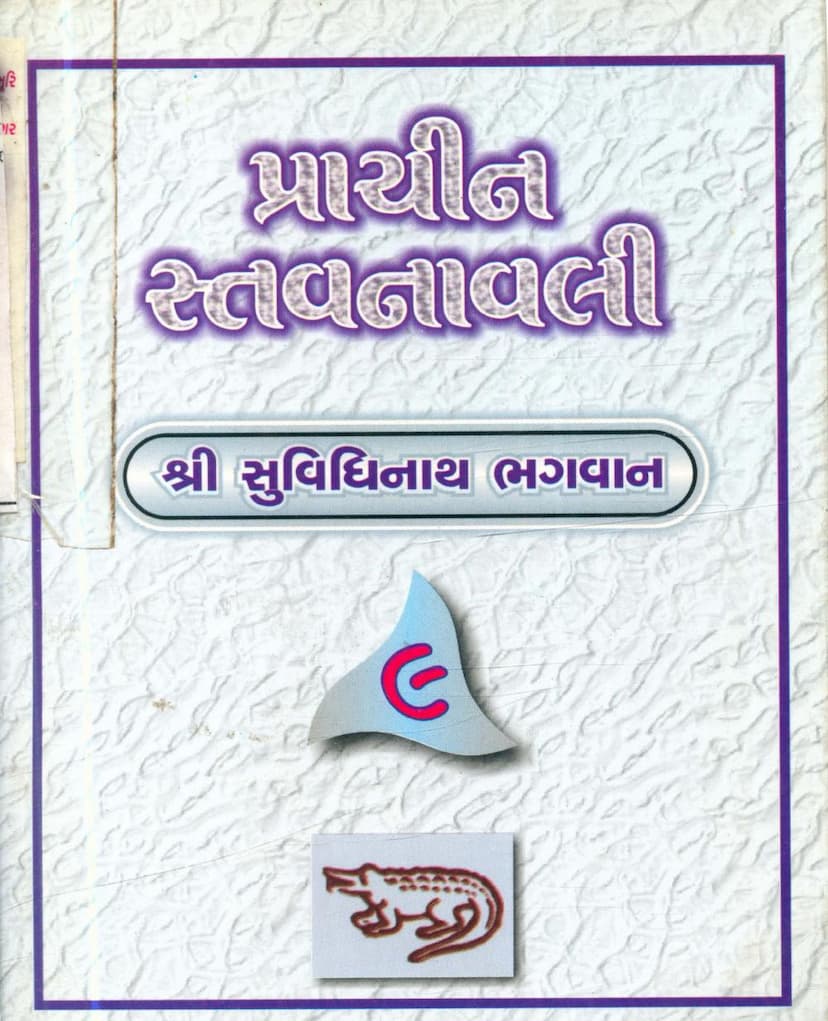Prachin Stavanavli 09 Suvidhinath
Added to library: September 2, 2025

Summary
Here is a comprehensive summary of the Jain text "Prachin Stavanavli 09 Suvidhinath," authored by Hasmukhbhai Chudgar, based on the provided pages:
Overall Purpose and Introduction:
The book, "Prachin Stavanavli 09 Suvidhinath," is a compilation of devotional songs (stavan) dedicated to Lord Suvidhinath, the ninth Tirthankar in Jainism. The core purpose of these stavan is to foster devotion (bhakti) towards the divine, enabling individuals to transcend worldly suffering and attain the state of liberation (moksha). The introductory pages emphasize that true devotion arises from understanding the true nature of the soul and the divine, rather than mere mechanical repetition. The collection aims to provide a means for spiritual upliftment and closer proximity to the ultimate truth through the appreciation of ancient devotional literature.
Key Themes and Content:
-
The Greatness of the Navkar Mantra: Page 2 highlights the supreme significance of the Navkar Mantra, describing it as the essence of the fourteen Purvas. It is presented as a mantra to be recited in all circumstances – joy or sorrow, day or night, living or dying. Its 68 letters are considered sacred, like 68 holy places, and it bestows eight types of prosperity and eight siddhis (supernatural powers). Chanting it leads to the attainment of the supreme soul-state.
-
Devotion to Lord Suvidhinath: The primary focus of the book is on Lord Suvidhinath. The various stavan are prayers, praises, and expressions of love and yearning for him. They describe his divine qualities, his life events, and the benefits of devotion to him.
-
Biographical Details of Lord Suvidhinath:
- Parentage: His father was King Sugriv, and his mother was Queen Rama.
- Birthplace: He was born in the city of Kakandi.
- Lifespan and Physique: His lifespan was 200,000 Purva (a unit of time), and his height was 100 Dhanush (a unit of measurement).
- Mark (Lanchhan): His emblem is a crocodile (Magar).
- Other Names/Attributes: He is also referred to as Pushpadant, Sugriv-kulachanda (ornament of the Sugriv dynasty), and one who bestows well-being.
- Spiritual Journey: He attained liberation (moksha) from Sametshikhar mountain.
- Followers: He had 200,000 monks and 100,000 nuns, as well as a significant number of lay followers.
- Yaksha and Yakshini: His attendant deities are Ajit (Yaksha) and Sutara (Yakshini).
- Kalyanaks (Significant Life Events): His Chyaavan (descent into the womb) was on Falgun Vad 9, Janma (birth) on Magshar Vad 5, Diksha (renunciation) on Magshar Vad 6, Kevalgyan (omniscience) on Kartik Sud 3, and Moksha (liberation) on Bhadrapad Sud 9.
-
The Nature of Devotion (Bhakti):
- Beyond Rituals: The stavan emphasize that true devotion is not just about outward rituals but about a sincere and heartfelt connection with the divine.
- Overcoming Worldly Attachments: Devotion helps in overcoming desires, attachments, and the suffering caused by the cycle of birth and death.
- Transformative Power: Devotion is depicted as a source of strength, purity, and spiritual growth, capable of transforming the devotee.
- Gratitude: The text encourages a feeling of gratitude towards the Tirthankars for their guidance.
-
Structure and Content of the Stavan:
- Variety of Authors: The collection includes stavan by numerous revered Jain monks and scholars, such as Yashovijayji, Anandghanji, Bhanvijayji, Anandvardhanji, Manvijayji, Gyanvimal Suri, Bhavvijayji, Vinayvijayji, Harakchandji, Nayvijayji, Rishabhsagarji, Udayaratna ji, Jinvijayji, Hansaratna ji, Mohanvijayji, Ramvijayji, Kantivijayji, Nyaysagarji, Padmavijayji, Vijaylaxmisuri, Kirtivimalji, Danvijimalji, Vineetvijayji, Amrutvijayji, Pramodsagarji, Bhanuchandji, Khushalmuni, Chaturvijayji, Devchandji, Jivanvijayji, Danvijayji, Meghvijayji, Kesharvimalji, Kanakvijayji, Ruchirvimalji, Bhavprabh Suri, Ratanvijayji, Manek muni, Deepvijayji, Dharmkirtigani, Swarupchandji, Jashvijayji, Gunvilasji, Jagjivanji, and Jinhershji.
- Diverse Styles and Melodies: The stavan are composed in various ragas (melodies) and meters, indicating their lyrical and devotional nature.
- Poetic Expressions: The lyrics use rich metaphors and poetic language to express the deep reverence and longing for Lord Suvidhinath. They compare the devotee's love for the Lord to natural phenomena like the moon and the cuckoo's love for the clouds.
- Emphasis on Virtues: Many stavan highlight the virtues that one can attain by devotedly remembering and serving Lord Suvidhinath, such as peace, knowledge, detachment, and liberation.
-
Chaiyavandana Vidhi (Ritual of Reverence):
- Pages 9-14 detail the procedural aspects of performing Chaiyavandana, the ritualistic worship of Jain idols and temples.
- This includes specific sutras (chants) like "IrIyavahiya," "Kaussagga," "Logassa," and "Namostuṇe," which are recited during the ritual.
- The meaning and purpose of each sutra are explained, emphasizing purification, veneration, and seeking blessings.
- The importance of sincere intention and proper execution of the rituals is underscored.
Publisher and Availability:
- Publisher: Hasmukhbhai Chudgar.
- Contact/Location: 202-203, Chinubhai Centre, Ahmedabad - 380009.
- Edition: 1000 copies printed.
- Price: "Shraddha Bhakti" (Faith and Devotion), indicating it is not sold for monetary profit but for spiritual contribution.
In essence, "Prachin Stavanavli 09 Suvidhinath" is a significant Jain devotional text that offers a comprehensive collection of hymns and prayers dedicated to Lord Suvidhinath. It serves as a guide for devotees to deepen their understanding and practice of Jain devotional principles, highlighting the transformative power of faith and the ultimate goal of spiritual liberation.